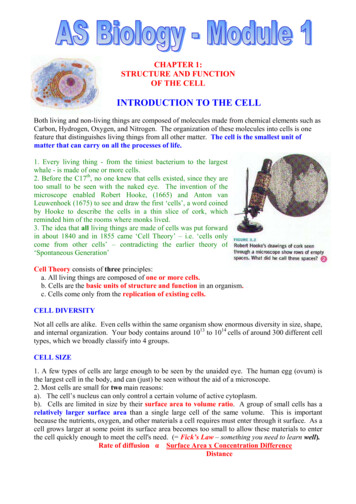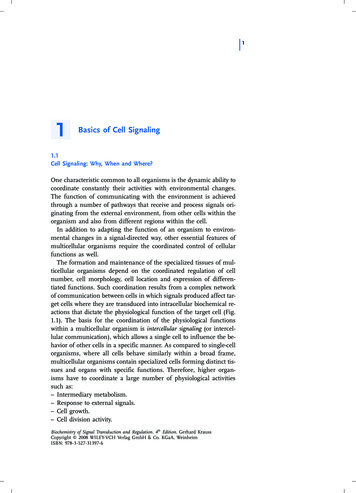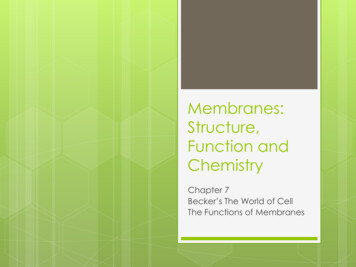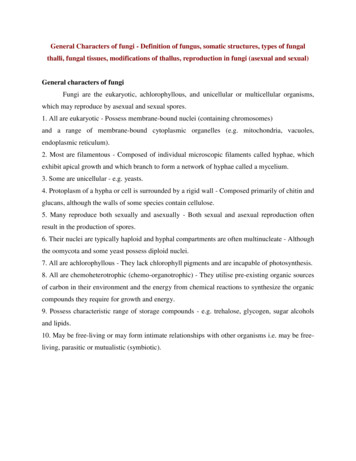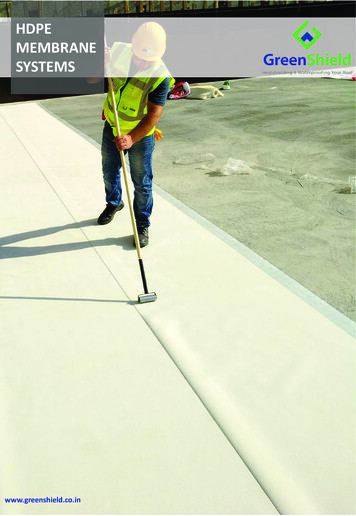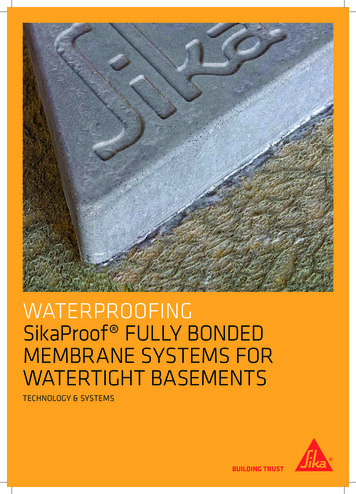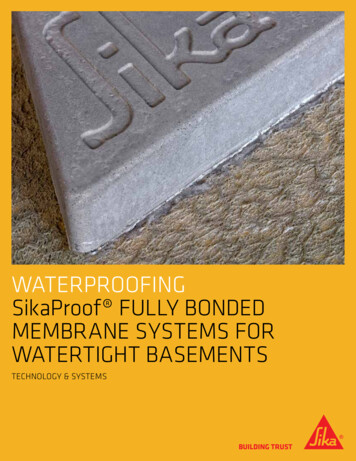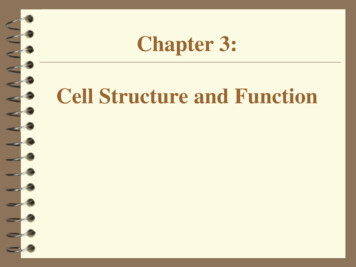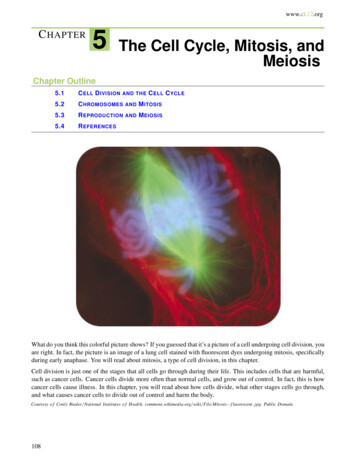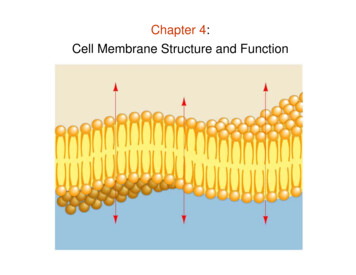
Transcription
Chapter 4:Cell Membrane Structure and Function
Chapter 4: Membrane Structure and FunctionPlasma Membrane: Thin barrier separating inside of cell(cytoplasm) from outside environmentFunction:1) Isolate cell’s contents from outside environment2) Regulate exchange of substances between inside andoutside of cell3) Communicate with other cellsNote: Membranes also exist within cells forming variouscompartments where different biochemical processes occur
The Fluid Mosaic Model of Cellular Membranes:
Chapter 4: Membrane Structure and FunctionPhospholipid Bilayer: Double layer of phospholipids Hydrophilic ends form outer border Hydrophobic tails form inner layer Lipid tails of phospholipidsare unsaturated (C C)
Chapter 4: Membrane Structure and FunctionCell Membrane Proteins:1) Transport Proteins: Regulate movement of hydrophilic molecules throughmembraneA) Channel Proteins (e.g. Na channels)B) Carrier Proteins (e.g. glucose transporter)2) Receptor Proteins: Trigger cell activity when molecule from outsideenvironment binds to protein3) Recognition Proteins: Allow cells to recognize / attach to one another Glycoproteins: Proteins with attached carbohydrategroups
Chapter 4: Membrane Structure and FunctionHow are Substances Transported Across Membranes?Answer: Concentration GradientsConcentration Number of molecules in a given unit ofvolume (e.g. grams / liter; moles / liter)Gradient Difference between two regions of spacesuch that molecules move from one region tothe other
Chapter 4: Membrane Structure and FunctionDiffusion: Movement of molecules from an area of [high] to anarea of [low] Greater the concentration gradient, the faster diffusion occurs Diffusion will continue until gradient is eliminated (equilibrium) Diffusion cannot move molecules rapidly over long distances
Chapter 4: Membrane Structure and FunctionTypes of Movement Across Membranes:1) Passive Transport Requires no energy Substances move down concentration gradientsA) Simple Diffusion Small molecules pass directly through the phospholipidby-layer (e.g. CO2, H2O, O2)Rate depends on:1) Molecule size2) Concentration gradient3) Lipid solubility(Figure 4.3a)
Chapter 4: Membrane Structure and FunctionTypes of Movement Across Membranes:1) Passive Transport Requires no energy Substances move down concentration gradientsB) Facilitated Diffusion Molecules need assistance of channel proteins orcarrier proteins (e.g. ions, amino acids, sugars)Channel Proteins(Figure 4.3b)Carrier Proteins(Figure 4.3c)
Chapter 4: Membrane Structure and FunctionTypes of Movement Across Membranes:1) Passive TransportA) Simple Diffusion Requires no energyB) Facilitated Diffusion Substances move down concentration gradientsC) Osmosis Movement of water from an area of high [water] to areaof low [water] across semi-permeable membranewater
Chapter 4: Membrane Structure and FunctionOsmosis:water
Chapter 4: Membrane Structure and FunctionOsmosis and Living Cells:Isotonic Solution: Outside of cell has same [solute]as inside of cell(no net water movement)
Chapter 4: Membrane Structure and FunctionOsmosis and Living Cells:Isotonic Solution: Outside of cell has same [solute]as inside of cellHypertonic Solution: Outside of cell has higher [solute]than inside of cell(net water movementout of cell)
Chapter 4: Membrane Structure and FunctionOsmosis and Living Cells:Isotonic Solution: Outside of cell has same [solute]as inside of cellHypertonic Solution: Outside of cell has higher [solute]than inside of cellHypotonic Solution: Inside of cell has higher [solute]than outside of cellTonicity is relativeto the inside of the cell(net water movementinto cell)
Chapter 4: Membrane Structure and FunctionTypes of Movement Across Membranes:1) Passive Transport2) Active Transport Requires energy (ATP) Substances move against concentration gradients
Chapter 4: Membrane Structure and FunctionTypes of Movement Across Membranes:1) Passive Transport2) Active Transport3) Endocytosis Movement of large particles into cells (vesicle formation)1) Pinocytosis (“cell drinking”) Uptake of fluid droplets2) Receptor-mediated Endocytosis: Uptake of specific molecules via coated pits3) Phagocytosis (“cell eating”) Uptake of large particles (e.g. bacteria)
Chapter 4: Membrane Structure and FunctionEndocytosis:(Figure 4.7)
Chapter 4: Membrane Structure and FunctionTypes of Movement Across Membranes:1) Passive Transport2) Active Transport3) Endocytosis4) Exocytosis Movement of large particles out of cells (e.g. hormones)
Chapter 4: Membrane Structure and FunctionExocytosis:(Figure 4.9)
Chapter 4: Membrane Structure and FunctionHow are Cell Surfaces Specialized?Answer: Junctions allow cells to connect and communicate1) Connection Junctions:A) Desmosomes: Hold cells together via protein filaments(Figure 4.10a)
Chapter 4: Membrane Structure and FunctionHow are Cell Surfaces Specialized?Answer: Junctions allow cells to connect and communicate1) Connection Junctions:B) Tight Junctions: Protein “seals” prevent leakage (cell cell)(Figure 4.10b)
Chapter 4: Membrane Structure and FunctionHow are Cell Surfaces Specialized?Answer: Junctions allow cells to connect and communicate2) Communication Junctions:A) Gap Junctions: Protein channels allowing for signals topass between cells (animals)(Figure 4.11a)
Chapter 4: Membrane Structure and FunctionHow are Cell Surfaces Specialized?Answer: Junctions allow cells to connect and communicate2) Communication Junctions:A) Plasmodesmata: Cytoplasmic bridges allowing forsignals to pass between cells (plants)(Figure 4.11b)
Chapter 4: Membrane Structure and FunctionHow are Cell Surfaces Specialized?Answer: Cell walls offer support and protectionCell Walls: Found in bacteria, plants, fungi, & some protists Composed of carbohydrates (e.g. cellulose, chitin),proteins, or inorganic molecules (e.g. silica) Produced by the cell it protects/supports
Chapter 4: Membrane Structure and FunctionCell Wall:(Figure 4.12)
Chapter 4: Membrane Structure and Function Cell Membrane Proteins: 1) Transport Proteins: Regulate movement of hydrophilic molecules through membrane A) Channel Proteins (e.g. Na channels) B) Carrier Proteins (e.g. glucose transporter) 2) Receptor Proteins:
